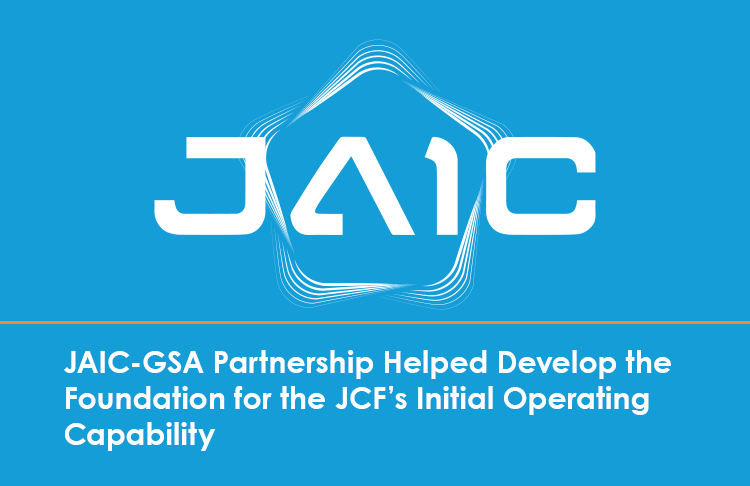JAIC-GSA Partnership Helped Develop the Foundation for the JCF’s Initial Operating Capability
- By: JAIC Public Affairs

JAIC-GSA Partnership Helped Develop the Foundation for the JCF’s Initial Operating Capability The collaborative nature of the Joint Artificial Intelligence Center can be seen in its highly successful partnership with the General Services Administration’s IT Modernization Centers of Excellence (CoE). Announced initially in September 2019, the nine-month long discovery sprint got fully underway in early 2020. The dual intent of this effort has focused not only on accelerating the JAIC’s operational maturity, but also to develop lessons learned that will expand the adoption of Artificial Intelligence-enabled tools across the federal government.
The seven-member GSA team from the AI and Cloud Adoption CoE has helped the JAIC achieve a number of critical capabilities, including designing an agile acquisition strategy for Artificial Intelligence, providing unified program management and infrastructure support, and developing a robust AI Capability Maturity Model and AI Workforce Model. The team also supported the creation of the First Five Consortium, a one-of-a-kind public/private partnership that will provide unified AI-enabled Humanitarian Assistance and Disaster Response capabilities for America’s First Responders that are expected to go into operation in 2021.
Most critically, perhaps, the GSA CoE team worked together closely with the Joint Common Foundation to set the foundation for the platform’s Initial Operating Capability (IOC), which will launch in early 2021. Key to this effort were three areas of expertise:
- Agile acquisition. The GSA CoE team assisted in creating modern acquisition strategies for various contracts around AI-specific data readiness, test, development, and evaluation activities. This support extended to the JCF in 2020 which awarded several critical contracts: the Prime Integrator contract in August, which will deploy capabilities for the IOC and future iterations; an infrastructure and engineering support contract to help implement the JCF task management system and new capabilities for developers; and a DevSecOps contract to bring in additional expertise to help build DevSecOps capabilities for Artificial Intelligence/Machine Learning Ops.
- Technical advising on the JCF data strategy and CONOPS. The GSA CoE team provided support for creating a data governance framework, establishing data management procedures, and developing a JCF data asset catalog. This work included designing a JCF data pipeline that can accommodate the highly diverse needs of the JAIC’s Mission Initiatives and investigating the full range of open source and cloud-native data management platform solutions available currently, as well as surveying and interviewing users about their specific data management needs.
- Enabled environments for AI/ML DevSecOps for the JCF. This required a number of steps, beginning in March 2020, when the GSA CoE team authored three guiding documents: 1) DevSecOps best practices; 2) code sharing best practices; and 3) a list of AI and data tools. As the GSA CoE team moved out of its initial discovery phase and into the implementation phase, these documents acted as roadmaps for the JCF team. The GSA AI and Cloud Adoption CoE, in fact, relied on them to help manage the infrastructure and engineering support contract, help support the JCF’s transition to Cloud One/Platform One, set up new web services environments, and deploy new developer capabilities. As the year comes to a close, the GSA CoE team and the JCF are now relying on the documents to prioritize which services to turn on for each of those cloud platforms and in which order.
According to Bryan Lane, the GSA CoE’s deputy site lead for the JAIC who has also been serving as the JCF data branch chief, all of these steps were necessary to ramp up the JCF IOC, which is now scheduled to go live in February 2021. “When we launch, we’ll have the full stack of everything a data scientist, a software developer, a data engineer, a security practitioner, domain experts from the different Mission Initiatives, and external experts will need to kick off a project and get it started,” he said. “So, it’s really happening.”
The GSA CoE will continue supporting the JCF even beyond the IOC. For example, it is now working to create an AI tools census to capture and better understand the technical needs of users, especially early adopters “so we can further prioritize what capabilities we bring into the JCF after IOC and make informed decisions about how we invest,” Lane explained.
Lane noted that the GSA CoE and its effort is not a one-way street. Although it has brought its expertise and lessons learned from previous work to the JAIC, it is also capturing similar best practices in its ongoing work with the JAIC and will apply those to future AI efforts across the federal government. One lesson that the team brought but has expanded on during its last year at the JAIC is the value of working across an organization to build “canals and not wells, to make sure that as we put our heads down to build the JCF, we don’t lose sight of the broader picture, which is that the JAIC and the JCF are designed to serve others across the DoD.”
Lane noted that this ability to collaborate and share best practices is the beauty of the CoE model. As such, the JAIC and its partnership with the GSA CoE will ultimately be a model for the larger federal AI effort.
“We're learning together, and we're doing this together,” he stated. “Artificial Intelligence is not a mature capability practice area in the federal government. And so we're all learning as we go, and it takes work and it takes partnership and collaboration to make it happen, but this is an achievable mission.”